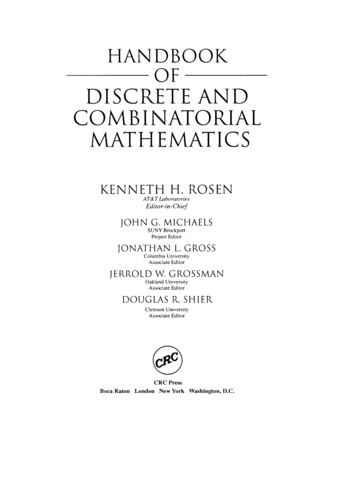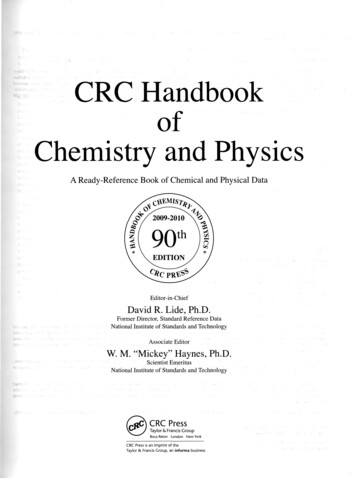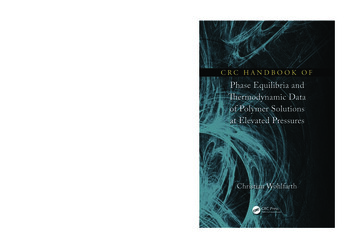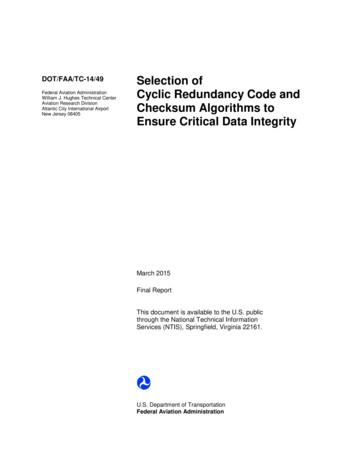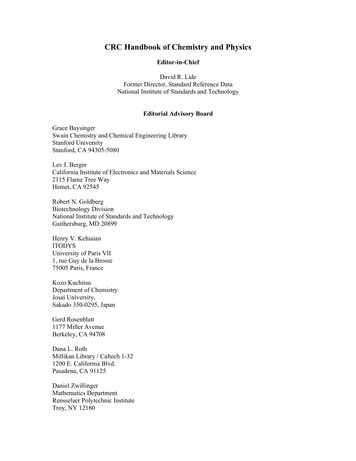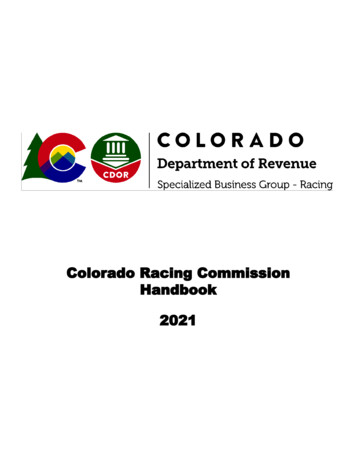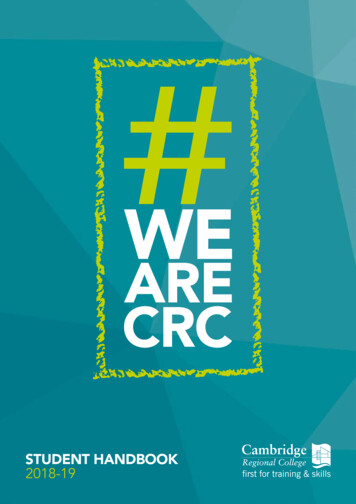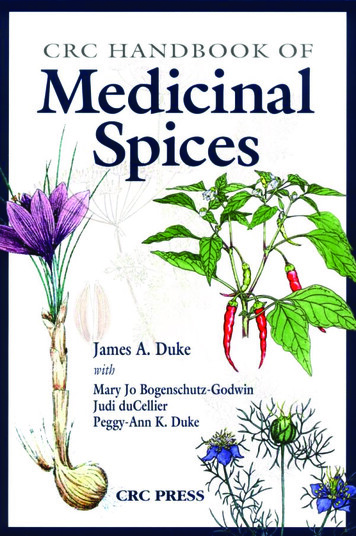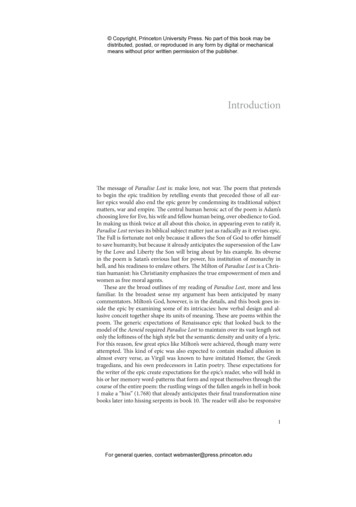
Transcription
Copyright, Princeton University Press. No part of this book may bedistributed, posted, or reproduced in any form by digital or mechanicalmeans without prior written permission of the publisher.IntroductionThe message of Paradise Lost is: make love, not war. The poem that pretendsto begin the epic tradition by retelling events that preceded those of all earlier epics would also end the epic genre by condemning its traditional subjectmatters, war and empire. The central human heroic act of the poem is Adam’schoosing love for Eve, his wife and fellow human being, over obedience to God.In making us think twice at all about this choice, in appearing even to ratify it,Paradise Lost revises its biblical subject matter just as radically as it revises epic.The Fall is fortunate not only because it allows the Son of God to offer himselfto save humanity, but because it already anticipates the supersession of the Lawby the Love and Liberty the Son will bring about by his example. Its obversein the poem is Satan’s envious lust for power, his institution of monarchy inhell, and his readiness to enslave others. The Milton of Paradise Lost is a Christian humanist: his Christianity emphasizes the true empowerment of men andwomen as free moral agents.These are the broad outlines of my reading of Paradise Lost, more and lessfamiliar. In the broadest sense my argument has been anticipated by manycommentators. Milton’s God, however, is in the details, and this book goes inside the epic by examining some of its intricacies: how verbal design and allusive conceit together shape its units of meaning. These are poems within thepoem. The generic expectations of Renaissance epic that looked back to themodel of the Aeneid required Paradise Lost to maintain over its vast length notonly the loftiness of the high style but the semantic density and unity of a lyric.For this reason, few great epics like Milton’s were achieved, though many wereattempted. This kind of epic was also expected to contain studied allusion inalmost every verse, as Virgil was known to have imitated Homer, the Greektragedians, and his own predecessors in Latin poetry. These expectations forthe writer of the epic create expectations for the epic’s reader, who will hold inhis or her memory word-patterns that form and repeat themselves through thecourse of the entire poem: the rustling wings of the fallen angels in hell in book1 make a “hiss” (1.768) that already anticipates their final transformation ninebooks later into hissing serpents in book 10. The reader will also be responsive1For general queries, contact webmaster@press.princeton.eduQuint Inside book crc.indb 110/15/13 12:03 PM
Copyright, Princeton University Press. No part of this book may bedistributed, posted, or reproduced in any form by digital or mechanicalmeans without prior written permission of the publisher.2 Introductionto the allusions embedded in the verses and responsible for integrating theminto the poem’s meaning. That the outspoken angel Abdiel in book 5 is a version, via Girolamo Vida’s Christiad, of the Bible’s Nicodemus defending Jesusbefore the Sanhedrin characterizes Abdiel as a superior figure of zeal; it alsoallows us to grasp the larger analogy that Milton is drawing between Satan’s andthe rebel angels’ refusal to acknowledge the Son and the understandable futureskepticism and anger of the Jews with regard to the same Son. Such epic poemsare preeminent examples of what Roland Barthes calls a “writerly” text, that is,a text that makes the reader do active and imaginative work in recomposing itsmeaning. Some assembly is required.1The studies of Paradise Lost in this book show what such assembly can revealabout the poetic texture and pleasure of Milton’s epic. They uncover verbal arrangements and thought structures that bind together—in widening configurations—episodes, individual books, motifs that run through the larger poem,and motifs running through Milton’s still larger career. In many instances, Ishow how these designs are built by and through Milton’s allusions—to theBible, to previous literature, particularly to the epic tradition (classical andmodern), and to his own earlier poetry.2 Milton uses allusion to construct andunify the fictions of the poem: the discussion in chapter 2 of how allusions tothe figure of Ulysses and to the myth of Scylla and Charybdis connect the various episodes of book 2 is perhaps the clearest, most systematic example. Suchpatterns have their own logic and tell their own stories, which complement andoverlap with the larger narrative that embeds them. At times close to its surface, at others submerged, they can organize a whole book of the poem.3 Fiveof the eight chapters of my book (1, 2, 4, 7, and 8) demonstrate the poetic unityof single books at either end of the epic (1, 2, 3, 10, and the composite 11–12,originally a single book 10 in 1667). The other three chapters (3, 5, and 6) covermuch of the poem that lies in between, and the book as a whole follows the narrative arc of Milton’s epic; I often return to its last books and ending. The second-order stories recounted through these designs—about poetry and idolatry,cosmology and materialism, envy and kingship, spiritual individualism versusloving community, death and choice, the status of women—turn out to be notsecondary after all, but centrally constitutive to the meaning of Paradise Lost. What is an allusion? In his classic essay on Lycidas, Northrop Frye writes thatfor a poet “the impulse to write can only come from previous contact withliterature, and the formal inspiration, the poetic structure that crystallizesaround the new event, can only be derived from other poems.”4 Poststructuralist thought, influenced by Barthes’s “death of the author,” conceives that a language or a tradition may write through a writer, and it labels this relationshipwith the catch-all term “intertextuality.” But the words on the page did not getthere by themselves. Cutting a theoretical Gordian knot, Stephen Hinds hasdistinguished allusion from seemingly infinite intertextual connections and theFor general queries, contact webmaster@press.princeton.eduQuint Inside book crc.indb 210/15/13 12:03 PM
Copyright, Princeton University Press. No part of this book may bedistributed, posted, or reproduced in any form by digital or mechanicalmeans without prior written permission of the publisher.Introduction 3reduction of such connections to so many commonplaces. Instead, Hinds defines allusion as a reference, chosen by the author, to an earlier text or texts inorder to produce an intended effect. Hinds accepts that the author’s intentionsare finally unknowable, and that “the alluding poet is ultimately and necessarily a figure whom we ourselves read out from the text” (50)—that is to say,allusion lies in the mind of the text’s interpreter. The latter may be a version ofBarthes’s “writerly reader,” but Hinds asks us to posit a poet whose “dialoguewith the work of other poets can be a very private, self-reflexive, and almostsolipsistic kind of dialogue” (49), an individual author who is alive and well.5The readings of Miltonic allusion that follow claim to recover the intentions ofa poet who, in these specific cases, cites or imitates earlier texts for calculatedpurposes and results. My critical task is to persuade my readers that these areinstances of allusion so defined. I also want to show how much of the powerand thought of Milton’s poetry can reside in its texture of allusions, how manyof the challenges and pleasures of reading Paradise Lost derive from puzzlingthem out.Let us begin with one complex but manageably brief example. In a passagein book 2 whose degree of irony is hard to determine, the fallen angels bowdown and reverence Satan as a god for his volunteering to voyage throughChaos to earth to seduce Adam and Eve, putting himself at risk for their generalsafety and deliverance from hell. (When we realize in retrospect, in book 3, thatSatan’s presenting himself for the mission has parodied the Son’s offer, throughhis future Passion, to deliver humanity from that mission’s consequences, theirony or lack of irony becomes that much harder to pin down.) The narratorcomments that the devils have not lost all their virtue, as this respect that theyshow for their leader’s own virtue testifies. He then goes on to make a parenthetical aside:Oh shame to men! Devil with devil damnedFirm concord holds, men only disagreeOf creatures rational, though under hopeOf heavenly grace: and God proclaiming peace,Yet live in hatred, enmity, and strifeAmong themselves, and levy cruel wars,Wasting the earth, each other to destroy:As if (which might induce us to accord)Man had not hellish foes enow besides,That day and night for his destruction wait.(2.496–505)6The sense of this grand invective seems clear enough. It is a paradox that humanbeings, who have hope of salvation, wage wars with each other while their realenemy is the devil, whose followers, though damned, live in concord with oneanother.For general queries, contact webmaster@press.princeton.eduQuint Inside book crc.indb 310/15/13 12:03 PM
Copyright, Princeton University Press. No part of this book may bedistributed, posted, or reproduced in any form by digital or mechanicalmeans without prior written permission of the publisher.4 IntroductionThe passage, however, carefully looks back into the epic tradition, the tradition that, as Milton will complain in the invocation to book 9, has deemed warsto be its only heroic argument (9.28–29). In twelve stanzas (2–13) of book 7 ofhis Os Lusíadas (1571), the Portuguese epic poet Luís de Camões denouncesProtestant schisms in Europe, but more generally inveighs against the wars thatChristians—“Ó míseros Cristãos”—wage among themselves, sowing the teethof Cadmus in internal strife (7.9), rather than coming together against theircommon Muslim enemy who, the poet notes, are completely united—“inteirosobservantes”—on the score of waging war upon them (7.10). In Richard Fanshawe’s 1655 translation, the poet enjoins Europeans to follow the exampleof his own crusading nation Portugal: “To scourge the arrogant Mahumetan/ Your hands unite, your heads together lay” (7.13). The Camões passage, inturn, is modeled on an earlier, similar invective (17.73–79) in Ludovico Ariosto’s 1532 version of the Orlando furioso, where the poet-narrator urges theEuropean peoples—Spaniards, French, Swiss, and Germans—who are nowfighting among themselves in Ariosto’s war-ravaged Italy to turn their warfareagainst the infidel, to reconquer Jerusalem from the “renegades” who now possess it and recapture Constantinople from the Turks (17.75). If, he says to thekings of France and Spain, you want, respectively, to be called “most Christian” and “Catholic,” why are you killing Christians—“Se Cristianissimi esservoi volete / e voi altri Catolici nomati / perché di Cristo gli uomini uccidete?”(17.75)—when you could go fight against the Muslim threat?7 The heroes of theOrlando furioso are themselves engaged in such a war, the conflict fought byCharlemagne against Agramante, king of Biserta; Milton has already comparedthe devils to the latter’s forces in book 1 (585–87). These epic forebears of Milton condemn contemporary war between Christians, but they are neverthelesssedulous to indite and glorify war that has the religious alibi of a crusade.Milton’s version of these earlier invectives substitutes the devil for the Mohammedan. It fits into a minor pattern in Paradise Lost that also finds Satandescribed as a Muslim potentate, labeled as a “sultan” (1.348; cf. “the soldan’schair” at 1.764), and the council of Pandaemonium a “dark divan” (10.457).8The most notable instance has appeared in the opening lines of the same book2, again through the use of allusion:High on a throne of a royal state, which farOutshone the wealth of Ormus and of Ind,Or where the gorgeous East with richest handShowers on her kings barbaric pearl and gold,Satan exalted sat (2.1–5)These lines echo the description of the Calyph of Egypt, the main power againstwhom the heroes of the First Crusade in Torquato Tasso’s Gerusalemme liberata(GL; 1581) will fight for the conquest of the holy city.For general queries, contact webmaster@press.princeton.eduQuint Inside book crc.indb 410/15/13 12:03 PM
Copyright, Princeton University Press. No part of this book may bedistributed, posted, or reproduced in any form by digital or mechanicalmeans without prior written permission of the publisher.Introduction 5Egli in sublime soglio, a cui per centogradi eburnei s’ascende, altero siede;e sotto l’ombra d’un gran ciel d’argentoporpora intesta d’or preme co’l piede,e ricco di barbarico ornamentoin abito regal splender si vede;(GL 17.10.1–6)[He on a high throne, to which one climbs by a thousand ivory steps, exalted (proudly) sits; and beneath the shade of a great heavenly canopy ofsilver, presses his feet on purple cloth interwoven with gold, and is seen toshine, rich in barbaric ornament and royal state (attire).]With a one-upmanship that is frequent in Miltonic allusion, Satan’s pomp outshines the regal trappings of Tasso’s Calyph, who incidentally numbers amonghis subject allies the kings of Hormuz (GL 17.25) and India (GL 17.28). Oneshould not make too much of this orientalizing conceit: Satan and the devilsare much more often described in terms of imperial and papal Rome and of theStuart monarchy. Kingship, in fact, more than Islam, seems to be the real targethere. Milton suggests that all earthly kings take their model from Satan, beforewhom their power in any case pales, and that there is no distinction betweenso-called Christian kings and Muslim despots to whom they may pretend to beopposed—they are all opposed to true Christianity.9Another erasure of the difference between Christian and Muslim, but thistime in the name of their common humanity, takes place in Milton’s “O shameto men!” invective. These two allusive passages in book 2, which now appearlinked to each other, group together Milton’s three major sixteenth-centuryChristian epic predecessors, Ariosto, Camões, and Tasso, whose poems recountconflicts between European Christian and African and Asian, mostly Muslim,forces, and appeal to the model of crusader warfare. But Milton evokes thesepoets’ alignment of the devil with the Mohammedan enemy in the book’s opening verses only to correct it in his subsequent invective. His imitation of Ariosto and Camões includes rather than excludes Muslims among the humanbeings—“men”—who wage wars against each other instead of attending totheir spiritual enemy, the devil. God, Milton writes in On Christian Doctrine(1.4), may ultimately reject the unbeliever, but he nonetheless bestows his graceon all (Works 14:146; CPW 6:192). In keeping with the general revision of epicin Paradise Lost, the book 2 passage condemns all human warfare, includingcrusades, and substitutes spiritual combat in its place: it is diabolic fraud ratherthan Muslim force of arms that we should fear. Nevertheless, the allusion itselfmakes the devil remind us of the Mohammedan and vice versa.Allusion functions in Paradise Lost as another layer of metaphor, or perhaps the better analogy is to Milton’s famous similes: it declares that a givenFor general queries, contact webmaster@press.princeton.eduQuint Inside book crc.indb 510/15/13 12:03 PM
Copyright, Princeton University Press. No part of this book may bedistributed, posted, or reproduced in any form by digital or mechanicalmeans without prior written permission of the publisher.6 Introductiondescription, action, whole scene is like, or just as often unlike, its counterpartin another text. This example demonstrates some features of Milton’s technique: the imitation of a passage from a poet that itself alludes to an earlierpoet (Camões to Ariosto); its linking to another allusion, often nearby or ina structurally prominent position (the initial allusion to Tasso), to suggest acontinuing conceit and formal arrangement; a rewriting, at times to the pointof inversion, of the meaning of the work alluded to. The application of theseearlier texts to his Genesis or pre-Genesis story, whose plot, of course, precedestheirs by thousands of years, is an instance of Milton’s frequent use of allusion to reverse his belatedness to his literary predecessors and to claim priorityover them—a point well made by Harold Bloom.10 But Milton’s allusion, here aselsewhere, is more than a reaction of poetic anxiety. His address to contemporary men and women also brings the deep past up-to-date. By allusion, Miltonplaces his poem within an ongoing literary history and a larger history, intellectual and political, in this case, the dilemma and contradictions that Christian thinkers, particularly sixteenth- and seventeenth-century Christians whoinherited the pacifist tradition of Erasmus, faced in confronting militant Islamand their own crusading past.11 This history seems, if anything, more timely atthe moment of my writing this study than when Milton composed his epic. Butwithout recognizing and taking account of the allusions—they are not noted inmodern editions—we would miss it altogether. To begin with, the subject of Milton’s condemnation: war. War comes first, toget it out of the way for love. Paradise Lost tells the story of two falls, which itsreader is asked to compare and contrast. There is the unending fall of Satan andhis followers, and there is the Fall—and spiritual regeneration—of Adam andEve. The fall of the rebel angels, noisy and full of the martial paraphernalia andheroics of earlier epic, is over and done with at the poem’s beginning: the defeated devils themselves have no more thirst for fighting epic battles. The poetnarrator invokes a Muse who was present from the first, that is, from the firstverses of Genesis and its account of the Creation, and then, surprisingly, asksthe Spirit to “Say first” (1.27)—and tell what happened still earlier. His prequelto the Bible allows Milton to manufacture, through the contrast between theself-tempting devils and the man and woman whom Satan deceives, a theological safety valve for humanity, and to rehearse, in parodic form, scenes from theolder epics his own poem supersedes. The first and last similes of book 1 notethe similarity of its portrait of the devils to sailors’ yarns and fairy tales, andRaphael’s account weaves the War in Heaven—a subject that is not scripturallyattested except in its anticipation/replay of the apocalyptic battles of Revelation—into the fables of Milton’s epic predecessors. The inset, retrospective formof Raphael’s narrative places the celestial war in a literary as well as a chronological past before the action of Paradise Lost begins. Raphael finishes the storyof Satan’s fall at the end of book 6 and halfway through the poem, leaving itsFor general queries, contact webmaster@press.princeton.eduQuint Inside book crc.indb 610/15/13 12:03 PM
Copyright, Princeton University Press. No part of this book may bedistributed, posted, or reproduced in any form by digital or mechanicalmeans without prior written permission of the publisher.Introduction 7second half to recount the fall of the first human couple, Milton’s new epicsubject, quieter if more talky. When Raphael recounts God’s creation of the universe in book 7, and Adam recounts his and God’s joint creation of Eve in book8 (in 1667 these were both part of a single book 7), Milton’s poem has caughtup to the Muse and to Genesis at the poem’s opening. By the end of ParadiseLost, however, when Michael tells of Eden’s being swept away by the Flood, itmay seem that its story of the human fall is itself receding into poetic fiction.Satan’s story is the old epic dispensation, the search for temporal power asa zero-sum game driven by envy and the desire for glory above one’s peers. Itcan only culminate, if not be satisfied, in kingship, war, and destruction—andin alienation from God in a literal or mental hell, the latter identical to remorse,the “restless thoughts” that return to torment the despairing fallen angels as thehellhounds sired by Death return to torment Sin. It may imply, in Milton’s century of astronomical revolution, the alienation from God of the universe itself, adestructive reversion to the infinite, random, and Babelic Chaos that surroundsbut is kept outside the walls of God’s new, orderly creation in Paradise Lost: epicwarfare extended to a warring cosmos, to noise and non-meaning. The fall ofAdam and Eve tells the story of the new dispensation of Milton’s epic: of howlove between human beings, here exemplified in marital love, enables (or is enabled by) the love of God; of the experience of spiritual goods that exceed finitetemporal ones; of hope for an existence beyond the finitude of death, summedup by Adam as “peace of thought.” Such love, in its fraternal, charitable form,also implies the political equality and liberty of a republic. In book 11, Milton’sGod takes credit for the reconciliation and renewal of their love that Adam andEve have worked hard to achieve in book 10, and the Son’s charity—his promisein book 3 of a future sacrifice for humanity repeated to the fallen couple in hisbook 10 oracle about the serpent and the woman’s seed—appears to have madeit possible. So, to the contrary, God hardens the heart of Satan, who refuses hisgrace.The Christian God’s new creative intervention and the poem’s declared pro ject of theodicy may provide the necessary conditions for, yet feel almost extraneous to, the foregrounded choices between power and love. (Or we could saythat the theodicy itself depends on whether we see God as power or as love.)By their own exercise of charity, Adam and Eve can attain a paradise withinin place of the one they have lost; and love seems to fulfill—and thus relegateto an older Law—the divine command of obedience. Paradise Lost restores tohumans the freedom of the angels who obey God: “we freely love, as in our will/ To love or not; in this we stand or fall.” But this freedom and love are nowdirected first of all to relationships between human beings.Even as the devil tries to draw God and the angels into the old epic battles,the human heroes engage in the new, more limited household world of theirgarden. The first couple fight, too, among themselves: the marital squabbleof hurt feelings that leads Eve to separate herself from Adam and head forFor general queries, contact webmaster@press.princeton.eduQuint Inside book crc.indb 710/15/13 12:03 PM
Copyright, Princeton University Press. No part of this book may bedistributed, posted, or reproduced in any form by digital or mechanicalmeans without prior written permission of the publisher.8 Introductionthe groves (where Satan lies in wait); the more serious exchange of mutualrecriminations after they have both fallen. The War in Heaven, the biggestbattle ever fought—so big that it mocks earlier epic and becomes mock-epic—is succeeded by battles of the sexes: these have their comical moments, too,in spite of their fraught circumstances. Milton changes his notes for tragicin book 9 when he must narrate the Fall, but, in spite of the bite that Deathand his remorse take out of human existence, in spite of the prophecies in thelast two books of the poem about war, kingship, empire, and misery in storefor human history, Adam and Eve leave Paradise Lost cheered, officially bythe happy ending of Christian promise, dramatically by the comic solution ofmarriage.12 No longer innocent, but now compromised human beings, theybelong to the emergent world of the novel, the lower narrative genre of comiccompromise that belongs to the subjected plain and domesticity to which theyare headed, a literary world where small things must perforce stand in placeof, and accomplish, great ones. Perhaps we are still in one kind of epic worldafter all: just as the Iliadic posturings of the devils in book 1 are replaced bytheir Odyssean fraud in book 2, so Milton’s larger epic may at its halfway pointreplace the little Iliad of the War in Heaven with an Odyssey of marital reunion; but the Odyssey, as James Joyce understood and proved, is the prototype of the novel. Paradise Lost starts with the devil. My first chapter shows how book 1 metapoetically depicts its own role in raising the rebel angels out of their “bottomlessperdition” (1.46), an act of poetic creation analogous to the divine creation ofthe universe described in the invocation—“how the heavens and earth / Roseout of chaos” (1.9–10). Framed by its first and last similes, which suggest thedevils are the unreliable figments of human tales, book 1 plays on perspectiveand size by reviewing, along with Satan, their “stature” and “number.” Afterinsisting on their gigantism, the similes, in order to count them, shrink thealmost innumerable devils into infinitesimal units to make them fit into thehuman mind, no less than they themselves voluntarily shrink to enter their newhome Pandaemonium. The profane temple Pandaemonium, raised by musicthat is hard to distinguish from the music of Milton’s own verses, is a first idolatrous counterimage of the poetic edifice that will be Paradise Lost. Its fallenarchitect Mulciber is the poet’s uncomfortably close double. The chief devilsdescribed in the catalog that occupies the center of book 1 and organizes its poetic figures and symbolic geography—Carthage, Sodom, Egypt, Babel-Babylon,Rome—are precisely those who will come to inhabit the pagan shrines thathuman idolatry will build next to or even inside the Jerusalem temple, profaning God’s house. If not merely the products of the human imagination, the demons take on the face and names that the imagination has granted them. Thiscatalog—whose traditional epic function is to size up military force—insteadsuggests the force of spiritual falsehood, and it corresponds to the defeatedFor general queries, contact webmaster@press.princeton.eduQuint Inside book crc.indb 810/15/13 12:03 PM
Copyright, Princeton University Press. No part of this book may bedistributed, posted, or reproduced in any form by digital or mechanicalmeans without prior written permission of the publisher.Introduction 9devils’ own reluctance to pursue another direct war against God; they wouldrather resort to satanic fraud. Milton not-so-gently mocks their military posturing, which is going nowhere except to build their council hall in which to sitand talk, and the contrast to earlier epic appears to diminish the devils, much asdoes their shrinking themselves at the book’s end. But the switch from swordsto words, from open force to lies, may make them more dangerous, not less, totheir human victims.In book 2, Milton continues this story of the demilitarization of the fallenangels and of his epic more generally when he bases all of its action around thefigure of Ulysses, the hero of eloquence and fraud, whose own epic comes in theaftermath of the Trojan War. Chapter 2 demonstrates that the Odyssey, imitatedand parodied in Satan’s voyage through Chaos to God’s newly created universein the book’s last section, is just one of the classical stories about the careerof Ulysses that Milton evokes as models for its different episodes. The variousparts of book 2 are held together by this pattern of allusion, as well as by theOdyssean figures of Scylla and Charybdis, the emblem of bad choices, or of lossof choice itself. Unable to die, the devils have no real option but to experiencethe second death of endless remorse. Here the Doloneia, that unheroic, evenspurious episode of the Iliad, in which volunteers are sought to go on spy errands from both Greek and Trojan camps, provides a central model in ParadiseLost, not only the model for Satan’s mission but for the Son’s subsequent offerto save humanity through his future incarnation and death. Thus, Milton’s epicinverts the idea of heroism itself. The hell constructed by the devils—what civilization looks like in the absence of God—is matched in book 2 by the Chaosthrough which Satan travels. This is a nature from which God has withdrawnhis creative hand.The next two complementary chapters turn to the confrontation of Milton’spoetry with cosmology in a century where earlier models of the universe hadbeen exploded by a new science and astronomy. Chapter 3 shows how, througha complicated chain of intermediary texts, the depiction of Satan’s fall throughChaos in book 2, which invokes the myth of Icarus, and the Son’s successfulride in the paternal chariot of God at the end of the War in Heaven in book 6,which rewrites the story of Phaethon, both trace back to the De rerum naturaof Lucretius. They counter the Roman poet’s depiction of an Epicurean cosmosordered by chance and in a constant state of falling through an infinite void—the “vast vacuity” of Chaos. Through allusion kept beneath the surface of thepoem, I suggest, Milton here faces his own deepest skepticism. The myths ofthese highfliers who fall are further countered in Paradise Lost by the motif ofpoetic flight. The shaping power of poetry itself and the epic high style counteract the specter of a universe without bound and dimension, or of the shapelessness of Death (“If shape it might be called that shape had none”). Poetry raisesthe poet over his fallen human condition, the sinking feeling of a Serbonian bogor slough of despond.For general queries, contact webmaster@press.princeton.eduQuint Inside book crc.indb 910/15/13 12:03 PM
Copyright, Princeton University Press. No part of this book may bedistributed, posted, or reproduced in any form by digital or mechanicalmeans without prior written permission of the publisher.10 IntroductionTo the hell and Chaos of book 2, book 3 opposes God’s heaven and his newcreation, the ordered universe, apparently presided over by the sun. But wherethe first two books describe their infernal realms by a kind of science fictioncomparison to fal
face, at others submerged, they can organize a whole book of the poem.3 Five of the eight chapters of my book (1, 2, 4, 7, and 8) demonstrate the poetic unity of single books at either end of the epic (1, 2, 3, 10, and the composite 11–12, originally a single book
